Key Historical Events to Understand Vietnam
Written in July 2020
The history of Vietnam is not only a dreadful war story with the Americans, it is as rich and full of twists and turns as anywhere on the planet. What many ignore is that the Vietnamese civilisation goes back centuries before the war, and is as sophisticated as its neighbour China, even though it is largely influenced by it due to a thousand-year occupation. Then came the French colonisation, mixed with a Japanese tentative domination, and finally an American invasion. Over the centuries, all those invaders would be vanquished, giving birth to national heroes whose exploits in expulsing foreigners have inspired generations of patriots.
Let’s start with some numbers always good to know for anyone interested in travelling to Vietnam soon:
Land area: 310,070 km²
Borders: 3 with Laos (2,161 km), Cambodia (1,158 km) and China (1,297 km)
Population: 97,363,318 (July 2020 est.)
Currency: US $1 = 23,200 VND / 1€ = 26,200 VND (July 2020)
Ethnicity: 54 (Kinh (Viet) 85.7%, Tay 1.9%, Thai 1.8%, Muong 1.5%, Khmer 1.5%, H'Mong 1.2%, Nung 1.1%, Hoa 1%, other 4.3%)
.jpg)
ORIGINS & LEGEND
Very little is known about the origins of the Vietnamese people. Until the 1960s, accounts of their origins were mainly based on Chinese sources according to which they would come from the Yue civilisation based in the South of China, translated by Viet in Vietnamese.
Southern Vietnam was part of the Indian-influenced Cambodian kingdom of Funan – known as the Khmers – centred around the great city of Angkor. The Funanese were experts in transportation and irrigation of rice with their main port established in the Mekong Delta.
Central Vietnam was then occupied by the Hindu kingdom of Champa, also Indian-influenced in their art and culture. The Cham were always looking to expand their territory, therefore constantly living in a state of war. Unfortunately for them, their neighbours, the Vietnamese to the North and the Khmers to the South, proved more powerful and the Cham ended up losing parts of their kingdom. Remains of their civilisation can be seen in My Son sanctuary near Hoi An.
In the absence of written history, the story of the ethnogenesis of the Viet people merges with legends which brings a hint of mystery. The Viet people would have been born from the love of the fairy queen Au Co, made from fire and the dragon Lord Lac Long Quan, made from water. From their love were born a hundred eggs. Since Water and Fire cannot remain together, Lac Long Quan and Au Co make the decision to separate, each taking fifty of their children. Half of their progeny followed their father to the sea, when the other half followed their mother in the mountains, to constitute the minority mountain ethnicities.
One of the mountain children became then the ruler of a kingdom called Van Lang, located in the Red River Delta, and birthed the Hong Bang dynasty. History then can take over.
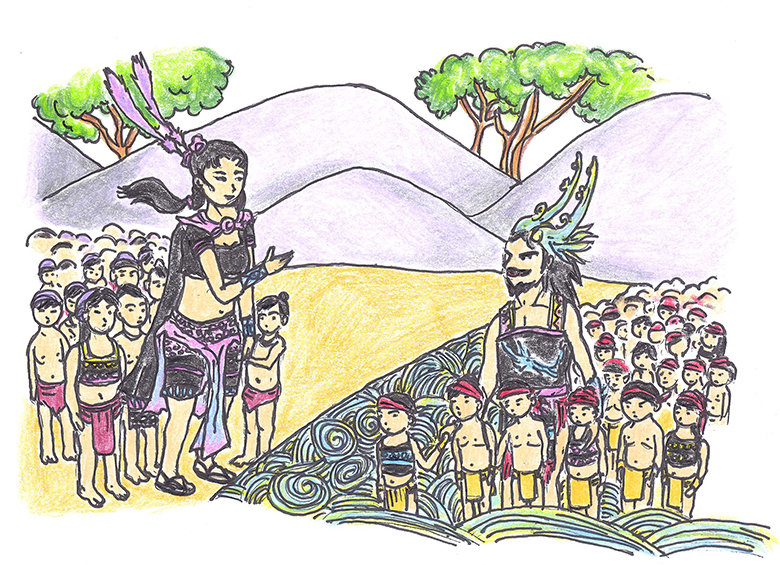
Drawing representing Au Co and Lac Long Quan saying goodbye, each taking fifty of their children
CHINESE DOMINATION
During more than 100 years, the Viet people will push back the Chinese soldiers. They will succeed until 111 BC when over succession disputes, China will see an opportunity to send troops and finally win. This victory will announce the beginning of over a millennium under Chinese domination.
Every conquest is accompanied by numerous battles, hundreds of death, forced labour and demands for tributes. However, over 1000 years and many rebellions – including the famous Trung Sisters who rallied the people and managed to push back the Chinese for 3 years – a sentiment of national identity started to grow amongst Vietnamese.
But every invader also brings many new innovations, scientific and medical knowledge, giving the early Vietnamese the tools to develop their country. Through the construction of dikes and irrigation systems to cultivate rice, the population expanded and headed South, towards the Cham kingdom, to gain more territories.
In the early 10th century, again over succession disputes but in China this time, the Vietnamese seized the opportunity to revolt and managed to gain their independence for more than two centuries, during which the Ly dynasty, followed by the Tran dynasty, continued the expansion, pushing the Cham more and more Southwards. Many enemies tried to attack – Chinese, Khmer, Cham and Mongol – but all were repelled. At least until the early 15th century, when China managed to seize control again for another 20 years thanks to… yes indeed another succession dispute.
This new attempt to force Vietnamese to become Chinese only strengthened their determination and in 1418, a movement of national resistance started. Eventually it succeeded in overthrowing Chinese dominion in 1428. Le Loi, wealthy landowner who started the movement, shortly after declared himself emperor and the Later Le dynasty started.
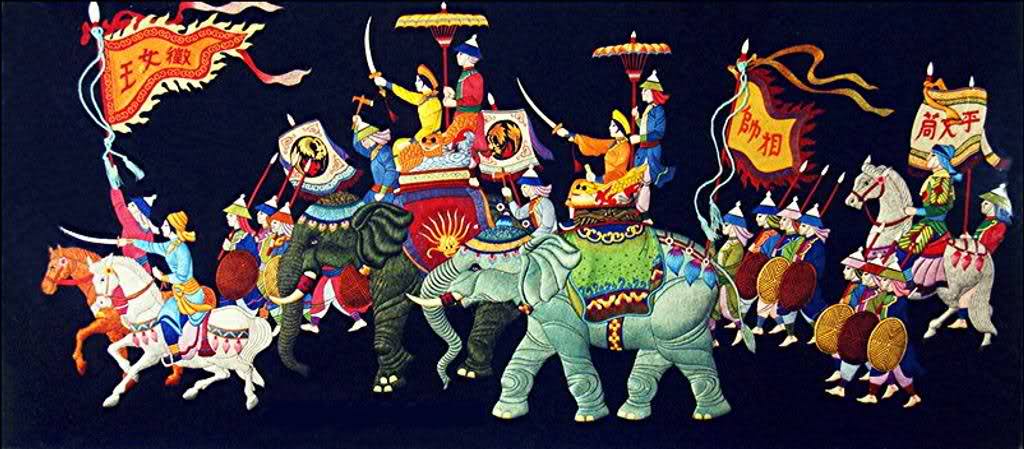
Representation of the Trung Sisters going to war riding elephants
INDEPENDENCE & DIVISION
This third dynasty introduced many reforms including a sophisticated legal code, introduced art, literature and education, developed agriculture, and drove the last of the Cham further South to retrieve their fertile lands between Da Nang and Nha Trang. The elimination of Champa was shortly followed by the conquest of the South and the Mekong Delta which still belonged to the Khmers. Saigon became Vietnamese before 1700 and the whole South followed over the next decades.
The country becoming stronger and the territory bigger, local governments were built which eventually ended up in civil wars and the division of the country twice over the next 150 years. The first division happened in 1527 when the strong Mac family deposed the Le rulers. The latter, with the help of loyal generals, regained gradually control after 50 years of civil war.
The second division now is of much greater significance. It occurred in 1620 when the Nguyen family – rulers of the Southern provinces from Hue since 1558 – rejected the sovereignty of the North. Tired of paying tributes to the Trinh family, representing the Le monarchs, many civil wars started ending by a 100-year truce in 1673. The truce was in fact a cover for a period of political chaos and revolution until three brothers – the Tay Sons – managed to overthrow the Southern regime in 1777, followed by the Trinh in the North in 1786.
The Chinese tried yet another invasion in 1788 but were unsuccessful. However, that same year, one Nguyen lord that escaped the massacre of his family, succeeded in defeating the Tay Sons by seeking the support of the French. Within 14 years, Nguyen Anh defeated the Tay Sons armies from South to North, using French military assistance, until finally complete victory in 1802. He adopted the title and name of Emperor Gia Long, and the country was then given the name of
Vietnam.
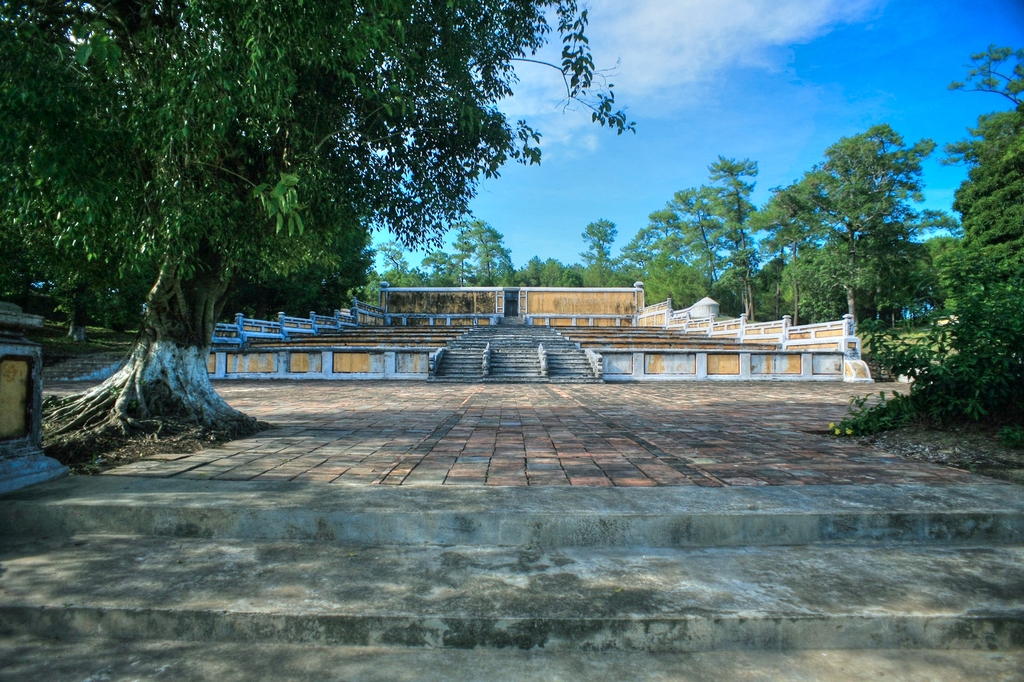
Entrance gate to Emperor Gia Long’s tomb, founder of the Nguyen dynasty - in Hue, central Vietnam
FRENCH COLONISATION
The first Western explorers, Portuguese, arrived in Vietnam in 1516. Over the following years, they developed a trading centre at Hoi An, central Vietnam, which explains the mix of cultures and architecture in this lovely city. More missionaries followed in the 16th century and the most famous of course is Alexandre de Rhodes, French, who completed a transcription of Vietnamese language into Roman script, still used today by modern Vietnamese.
Even though the French missionaries supported Nguyen Anh is regaining the kingdom from the Tay Sons, it was not until 1857 that the decision to invade Vietnam was taken by Napoleon III. It simply was the result of the upsurge of French capitalism, which fuelled the need for overseas markets and a larger French presence on the Asian territories. Therefore, in August 1858, the first vessels attacked the city of Da Nang in central Vietnam, and turned it into a French military base. Two weeks later, Saigon (Ho Chi Minh City) was seized.
The Vietnamese of course resisted, which slowed the progress of French troops. In 1867, the South of Vietnam became a French colony and received the name of
Cochinchina. Then 16 years later, in 1883, the whole country was conquered, the North was called
Tonkin by the French, and central Vietnam was named
Annam. The
Indochinese Union was officially announced in 1887, consisting of the colony of Cochinchina and the four protectorates of Annam, Tonkin, Cambodia and Laos.
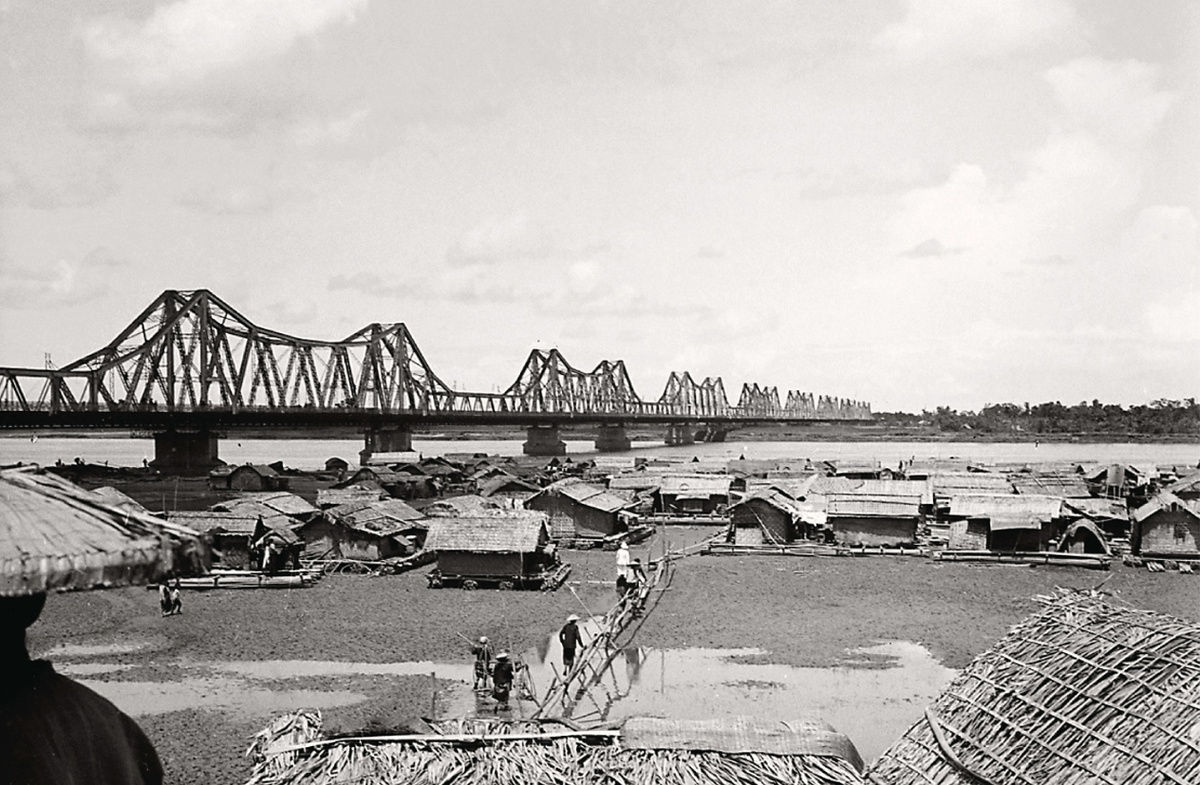
Long Bien Bridge crossing over the Red River, built between 1898 and 1902. It was named Paul Doumer Bridge during the colonisation after the Governor General of Indochina
The expansionist era came to a close and the Vietnamese were forced to return territory to the French colonial authorities. The French had great ambitions for the area, they started by imposing a Western-style administration leaving Vietnamese officials without any real power, and opening Indochina to economic exploitation for the benefit of France. Exporting Vietnam’s natural resources such as rice, coal, rare minerals and rubber, was the chief purpose of all French investors which were more interesting in attaining quick profit rather than developing the economy of the colony.
In summary, as the French became richer the Vietnamese were more and more deprived of any kind of right. Their lands were taken, education and medical care were scarce, civil liberties were non-existent and they were excluded from entering the trading and industrial sectors. The French policy lead to several movements of national liberation which grew stronger and stronger until one man made a difference in 1930 by creating the first Vietnamese Communist Party,
Ho Chi Minh, the most prominent figure in the national movement. Several uprising followed, causing heavy retributions by the French forcing the party back into hiding.
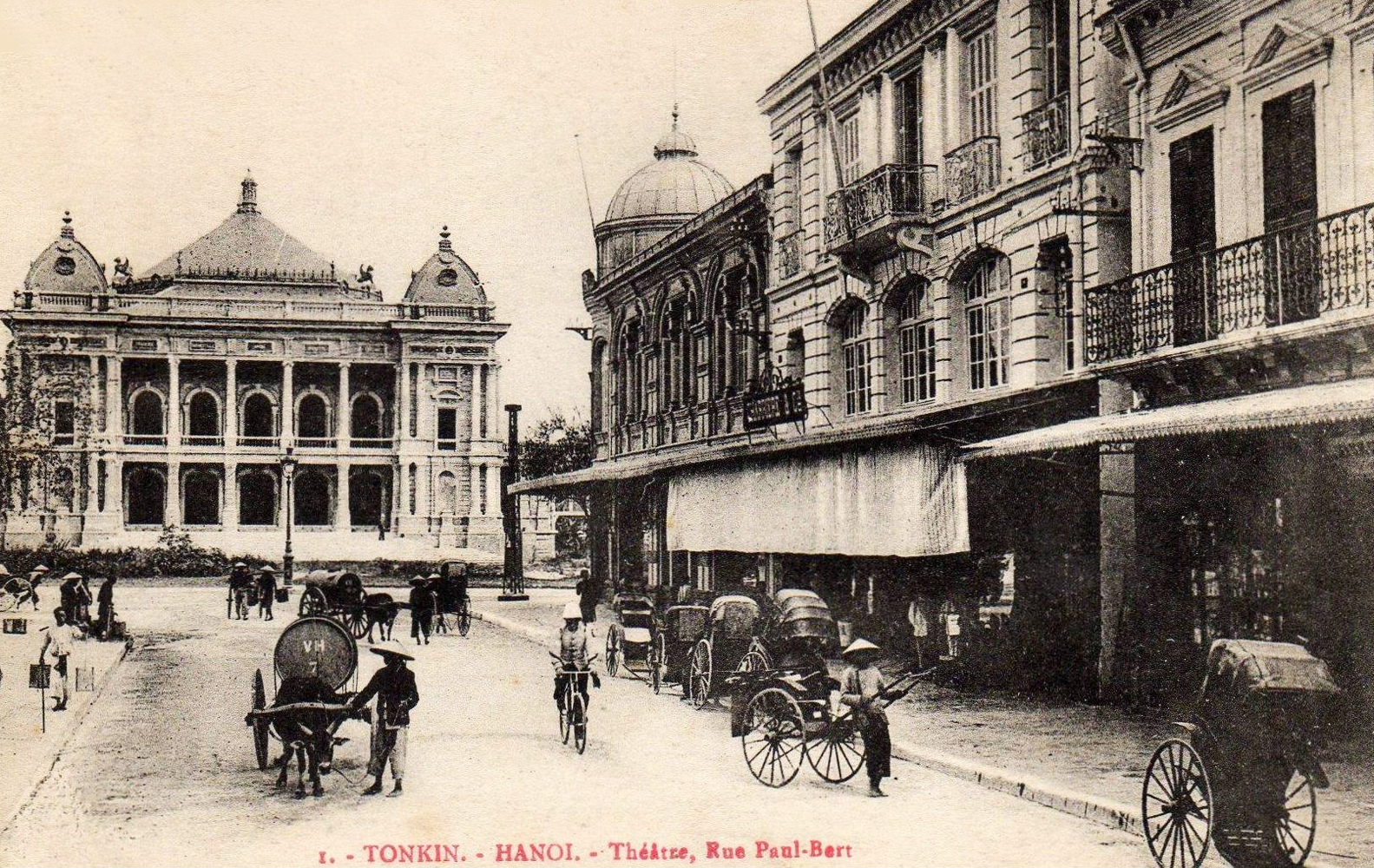
Hanoi Opera House built by the French between 1901 and 1911
WORLD WAR II, COMMUNISM & INDOCHINA WARS
As Europe entered World War II, Japan saw there a great opportunity to expand their presence in the country. So on the pretext of offering military assistance to the French in their colony while France was occupied by the Nazis, they slowly took control of Vietnam in 1940, keeping a French administration for political purposes only.
The Japanese occupation however offered another chance for the Vietnamese Communist Party – or Indochinese Communist Party as it was called since the late 1930s – to recover. In 1941, upon Ho Chi Minh’s request, the Party formed a nationalist alliance called the League for the Independence of Vietnam, later known as the
Viet Minh.
Ho Chi Minh played his cards very wisely and as the Allied forces attacked Japan after Pearl Harbor, he regularly informed them of the Japanese troops movements in Indochina. When Japan surrendered in August 1945, the French being disorganised after the war, the Viet Minh ordered a general uprising managing to seize power in Hanoi. The
Democratic Republic of Vietnam was born.
Even though the Communist Party had outmanoeuvred their rivals, the French were not done yet and set to restore their colonial presence in Indochina. With the help of British forces, they attacked from the South again seizing control of Cochinchina, thus creating in 1946, two Vietnams consisting of a communist North and a capitalist South.
At first, both parts signed a peace treaty declaring that France would recognise the Viet Minh government and give them the status of free state within the French Union. In addition, French troops were to withdraw progressively from the Northern part over five years. During this time, Ho Chi Minh consolidated the collaboration of the Viet Minh and the other nationalist groups.
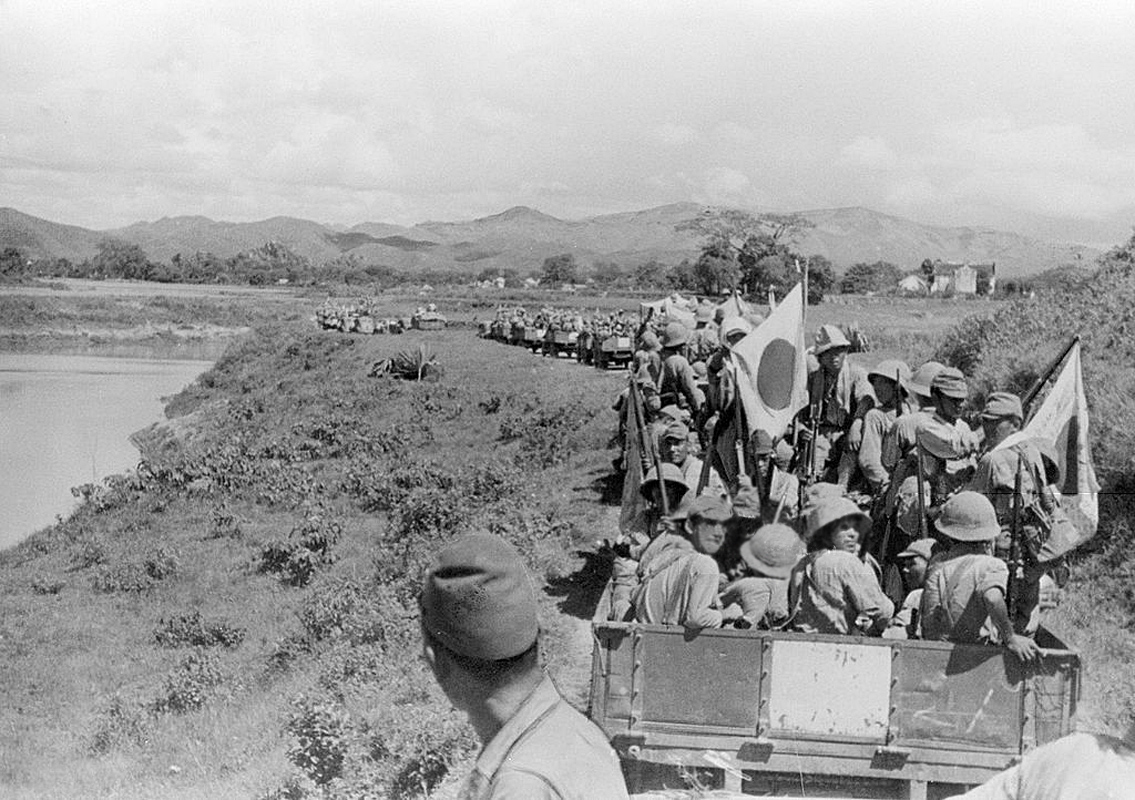
Japanese forces making their way into Lang Son, Northeast Vietnam in 1940
Despite the peaceful solution announced publicly, under the surface things were different: France had but one goal, to re-establish colonial rule, and the Viet Minh wanted total independence. After a few months only, French vessels bombarded Haiphong causing thousands of casualties, and the Viet Minh fought back in December 1946. The
First Indochina War had begun, eventually leading to a French victory thanks to their military superiority. This first war however only caused all Vietnamese – communists and non-communists – to rally and share a dream of independence.
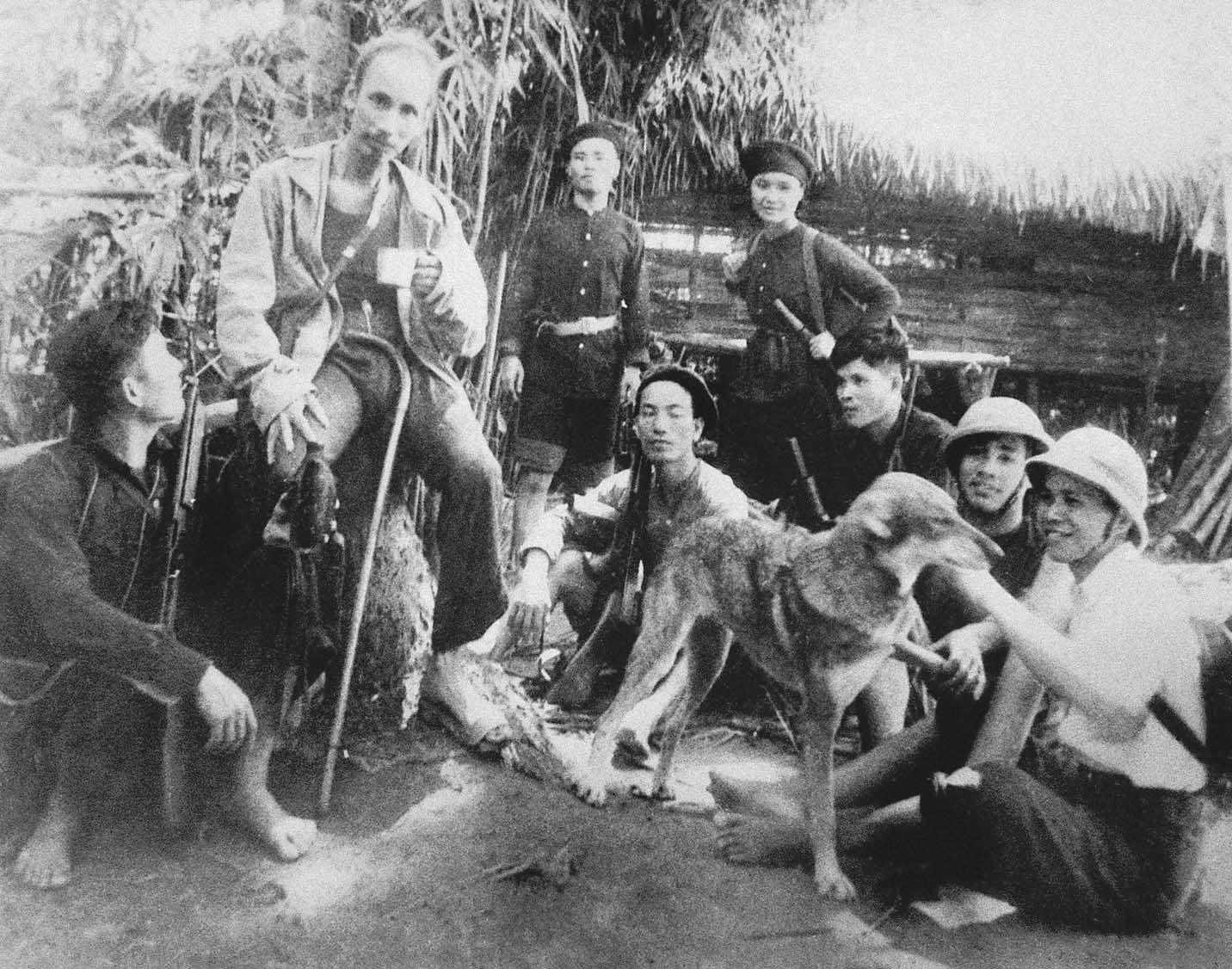
Ho Chi Minh (second left) with Viet Minh soldiers in 1947
Communist China supported greatly the nationalist Vietnamese movement and supplied gun power to aid in their revolt. This is the first time the United States of America would meddle in the Indochinese conflict and send large amounts of aid to the French, in an attempt to stop the spread of communism in Asia. But even with this additional support, the French lost their Northern base in Dien Bien Phu in 1954, which was capital to cut the nationalist supply lines into Laos and maintain a strong presence in the North.
Their defeat in Dien Bien Phu lead the French to negotiate an end to the war at an international conference in Geneva the same year. The
Geneva Accords declared a cease-fire and temporary division of the country into two military zones at latitude 17 °N – commonly called the 17th parallel. All Viet Minh forces were to withdraw North of that line, and the French to remain South. Elections were to be held in 1956 throughout Vietnam in order to unify the country, however the Southern leaders and the US did not approve out of fear that Ho Chi Minh would win, and the elections never happened.
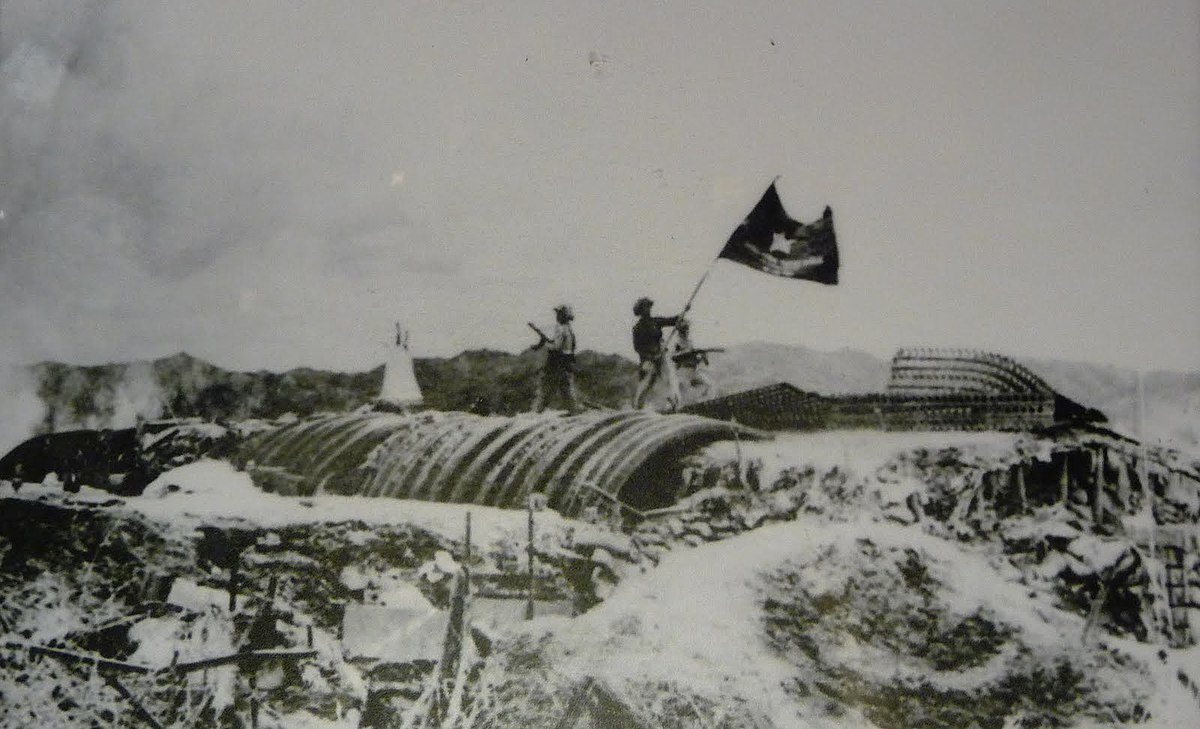
Viet Minh victory in Dien Bien Phu in 1954 marking the end of the First Indochina War with the French
In this fragile accord, the two Vietnam still began to rebuild. The North developed a program of socialist industrialisation as well as a collective agriculture system based on the communist principles, with the assistance of the Soviet Union and China. In the South, the model remained Western-influenced and with the support of the Americans, Ngo Dinh Diem, a Roman Catholic despite the majority Buddhist population, went from Prime Minister to President of the
Republic of Vietnam (South Vietnam) within a year.
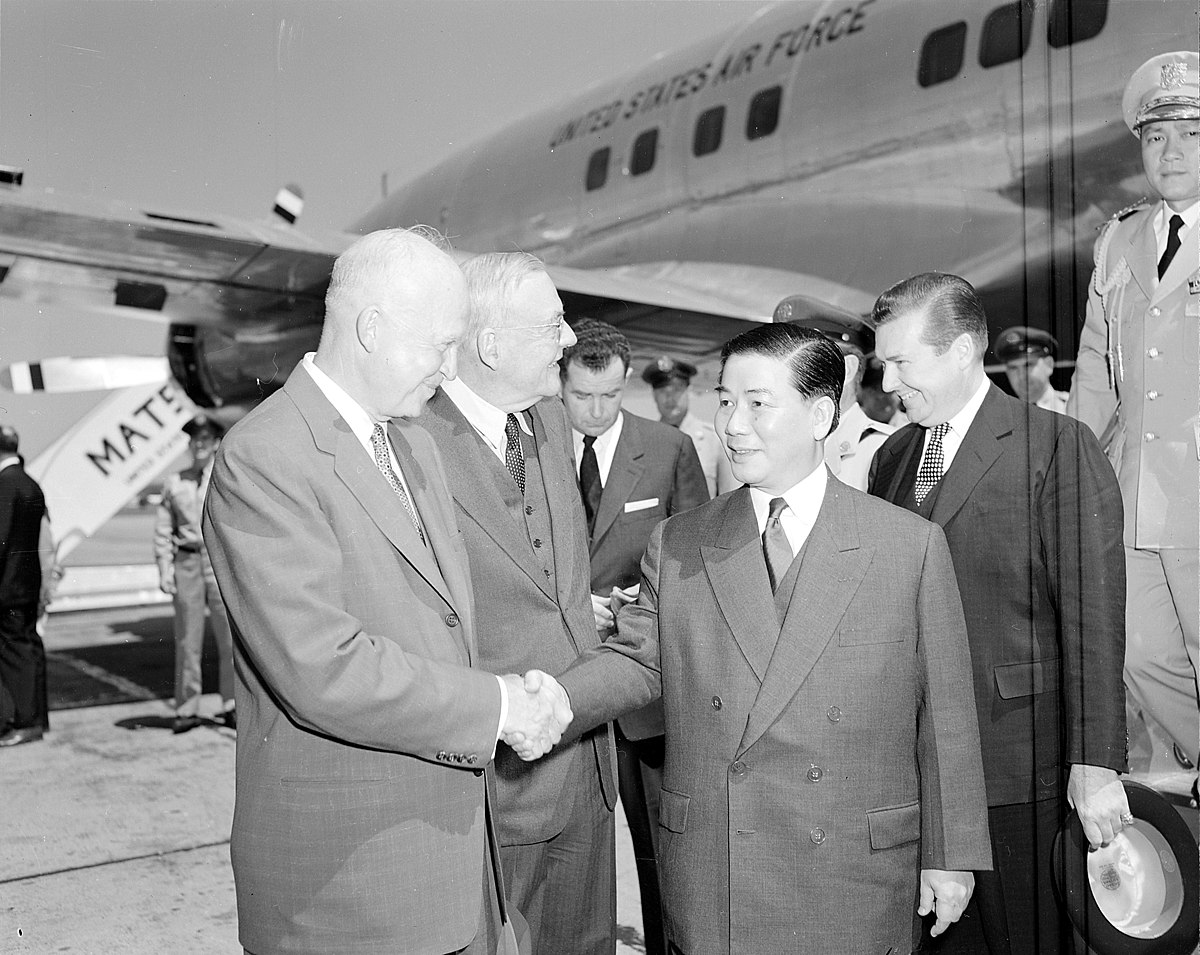
Ngo Dinh Diem, President of South Vietnam, during his visit to the US in Washington in 1957
Diem was a tyrannical ruler and employed strong measures against any opponent – political or religious. Running the government became a family affair as Diem’s brother, Ngo Dinh Nhu, founded an underground organisation to spy on officials and citizens and test their loyalty to the Ngo family. After Diem’s refusal to participate in the open elections agreed on in the Geneva Accords, the Northern communist forces – the
Viet Cong – launched an insurrection to conquer the South and finally unify the whole country. The movement almost succeeded as, in November 1963, Diem and his brother Nhu were killed in the coup.
A period of political instability followed in the South – seen as the
Second Indochina War – the Viet Cong infiltrated more and more the Southern part of the country receiving great support from the population on the way. But since the 1950s, Americans took a special interest in the area and protecting the Saigon regime became a symbol of their fight against communism. Until 1960, the US only participated financially in the fight, but the Viet Cong advancing more and more, further action was called for.
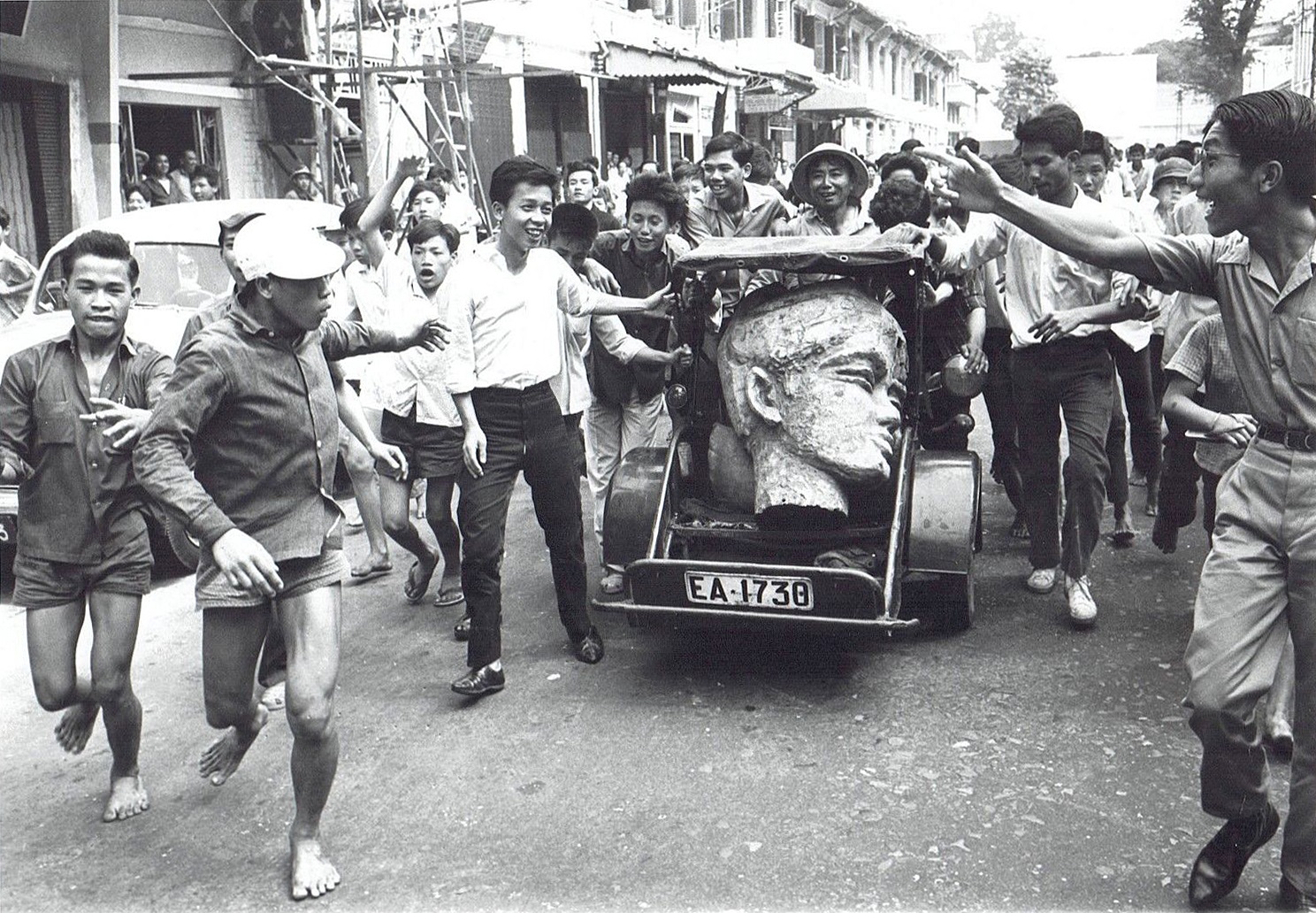
South Vietnamese celebrating the overthrow of Diem regime by the Viet Cong in November 1963
THE AMERICAN-VIETNAM WAR
Between 1960 and 1963, the number of American military equipment and ‘advisers’ for training the army, increased significantly. Soon US helicopter pilots and destroyers were deployed in an attempt to push back communism, personified by the Viet Cong. In February 1965, US President Johnson authorised the first bombings of North Vietnam. Four weeks and countless civil casualties later, the first US troops arrived in South Vietnam. In July 1965, the number of US soldiers had reached 75,000; by 1968 they were more than 500,000.
Three years of intensive bombing in the North – between 1965 and 1968 – and ground combats in the South, did not weaken the will of the Viet Cong and their allies. The famous
Ho Chi Minh Trails, crossing through Laos and Cambodia, helped thousands of Northern soldiers to reach the South and help the resistance. The North was well organised and in January 1968, they launched the Tet Offensive during which more than 100 cities and military bases were attacked, destroyed or seized by the Viet Cong.
These coordinated attacks showed the determination of the Vietnamese people and their continuing strength in the conflict. The American-Vietnam War became politically inacceptable and the number of bombings in the North of the country decreased, paving the way to peace negotiations in Paris from May 1968. However, as the Paris talks went on along with the withdrawal of US troops, new orders, coming from the newly elected US President Nixon, approved attacks on the Ho Chi Minh Trails in Laos and Cambodia.
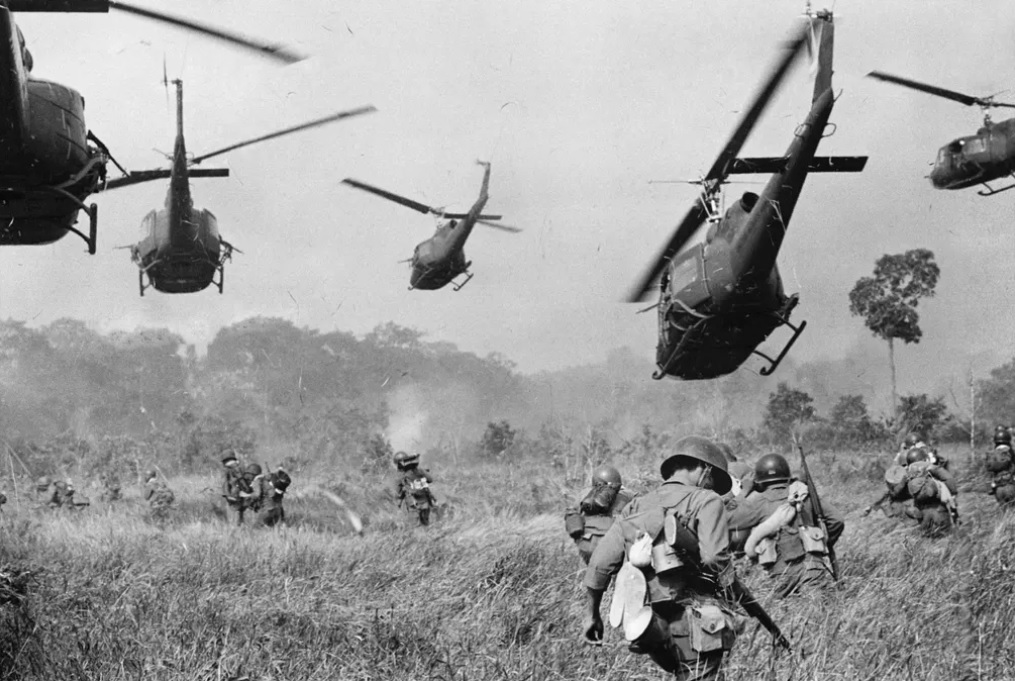
US Army helicopters opening fire into the tree line to cover the advance of South Vietnamese soldiers in near Tay Ninh on the border with Cambodia, in March 1965 (Photograph: Horst Faas/AP)
A South Vietnam police officer shooting a suspected Viet Cong on a Saigon street during the Tet Offensive in February 1968 (Photograph: Eddie Adam/AP)
The
Paris Agreement was finally signed in January 1973, a peace treaty providing for the complete withdrawal of the US troops within 8 weeks. So the Americans left but war was still not over, what about the Saigon regime in place? They still tried to eliminate the Southern communist allies of course. In the meantime, Hanoi had gathered enough strengths in the North, and was now convinced that the only way to unify the country was through an armed attack of the South to get rid of the opposition once and for all.
Within two years, the Northern Vietnamese troops marched South, passed the 17th parallel, and on April 30, 1975, the communists entered Saigon in triumph, smashing the gates of the Independence Palace with their tanks. The South government surrendered which put an end to the Second Indochina War, and Saigon was renamed after the greatest national hero, Ho Chi Minh, who had died in September 1969 of a heart attack.
Just a few hours after the surrender, the last Americans were evacuated by air, leaving behind the Vietnamese who supported them. Within the next five years, half a million of Vietnamese people would flee the now communist country. Those who left by sea became known as the ‘boat people’, and between pirates and storms, the survivors found refuge in Australia or France.
To sum up, official numbers show that 3.14 million Americans served in the US armed forces in Vietnam during the war, nearly 59,000 were killed or are listed as missing in action. On the Vietnamese side, around 224,000 South Vietnamese soldiers were killed in action, whereas North Vietnamese casualties have been estimated at 1 million. Approximately 4 million civilians were injured or killed during the war, many of them as a direct result of US bombings in the North. Still today at least 300,000 Vietnamese and 2,200 Americans are still listed as missing in action and the search continues.

A North Vietnamese tank entering through the gates of the Independence Palace of Saigon on April 30, 1975
REUNIFICATION & BIRTH OF A NATION
The country was officially reunified on July 2, 1976 when the
Socialist Republic of Vietnam was proclaimed, with Hanoi as capital city. Vietnam had now to face an incredible amount of political and economic problems to make this reunification work. The war left millions of people homeless or wounded across the country, an industrial as well as agricultural expansion was a necessity but implementing new reforms would turn out to be extremely difficult.
Indeed, the North of Vietnam had been at war for more than a generation and the new party members were not used in dealing with economic recovery problems. Between the resistance encountered in the South, the meddling of the Chinese and major floods and drought, things were very uncertain.
In addition to these internal issues, the regime also wanted to form an alliance with the governments of Laos and Cambodia, facing the hostility of the US and China which were eyeing cooperation with Vietnam’s neighbours. The Khmer Rouge regime, led by Pol Pot in Cambodia, however refused to participate, believing that the Vietnamese communists were looking at creating an Indochinese federation with Vietnam as the leader. As a result, the Khmer Rouge pushed back all the Vietnamese military forces from their country and attacked several Southern islands claiming they were part of their territory, killing hundreds of civilians in the process.
Pol Pot’s troops repeatedly attacked Vietnam over the following couple of years, supported by the Chinese, until Vietnam eventually decided to deal with these conflicts once and for all, and crossed the border to defeat the Khmer Rouge regime at the end of 1978. The Vietnamese government helped Cambodia installed a new government in Phnom Penh and supported them in rebuilding the country’s economic and educational systems.
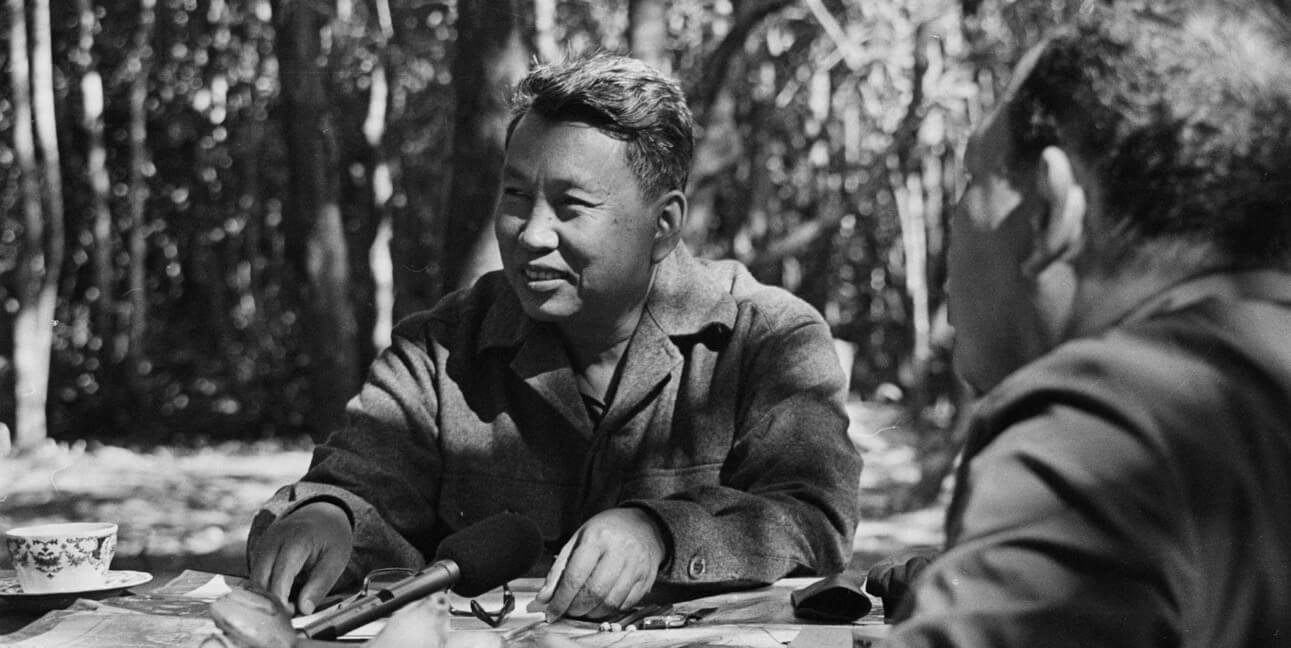
Pol Pot in the jungle of Cambodia giving an interview
Most of the Khmer Rouge survivors fled to Thailand and, with the support of China, reached out to the United Nations Security Council denouncing the Vietnamese occupation, omitting the abuses they committed themselves. Without any surprise, China, the US, France and more allied countries backed up the defeated Cambodian regime, imposing a trade embargo from most Western countries, leaving Vietnam more and more isolated from the world. Apart from the new Cambodian regime and the government of Laos, the Soviet Union and its European allies were the only ones standing by Vietnam.
So under such external pressure and the cost of stationing troops in Cambodia and at the Chinese border, the economic difficulties of Vietnam continued. Reforms needed to be taken and it is only in 1988, when the support of the Soviet Union was declining, that the government actually implemented an economic program aiming to liberalise trade, which proved efficient and helped stabilising the economy.
In an effort to improve relations with its neighbours, Vietnam removed its armed forces from Cambodia until 1989, however with the breakup of the Soviet Union in 1991, foreign affairs became more crucial than ever as the country was left completely alone. A peace conference held in Paris officially put an end to the Cambodian conflict the same year, making way to a normalisation of the relations with China, Japan and Europe.
The second agreement the Vietnamese signed was to help the US recover the American soldiers still missing in action. That key element encouraged the US to lift the embargo in 1994 and open diplomatic relations with Hanoi in 1995. Finally, Vietnam was accepted as a member of the ASEAN in 1995, symbolising its complete recognition as a nation.
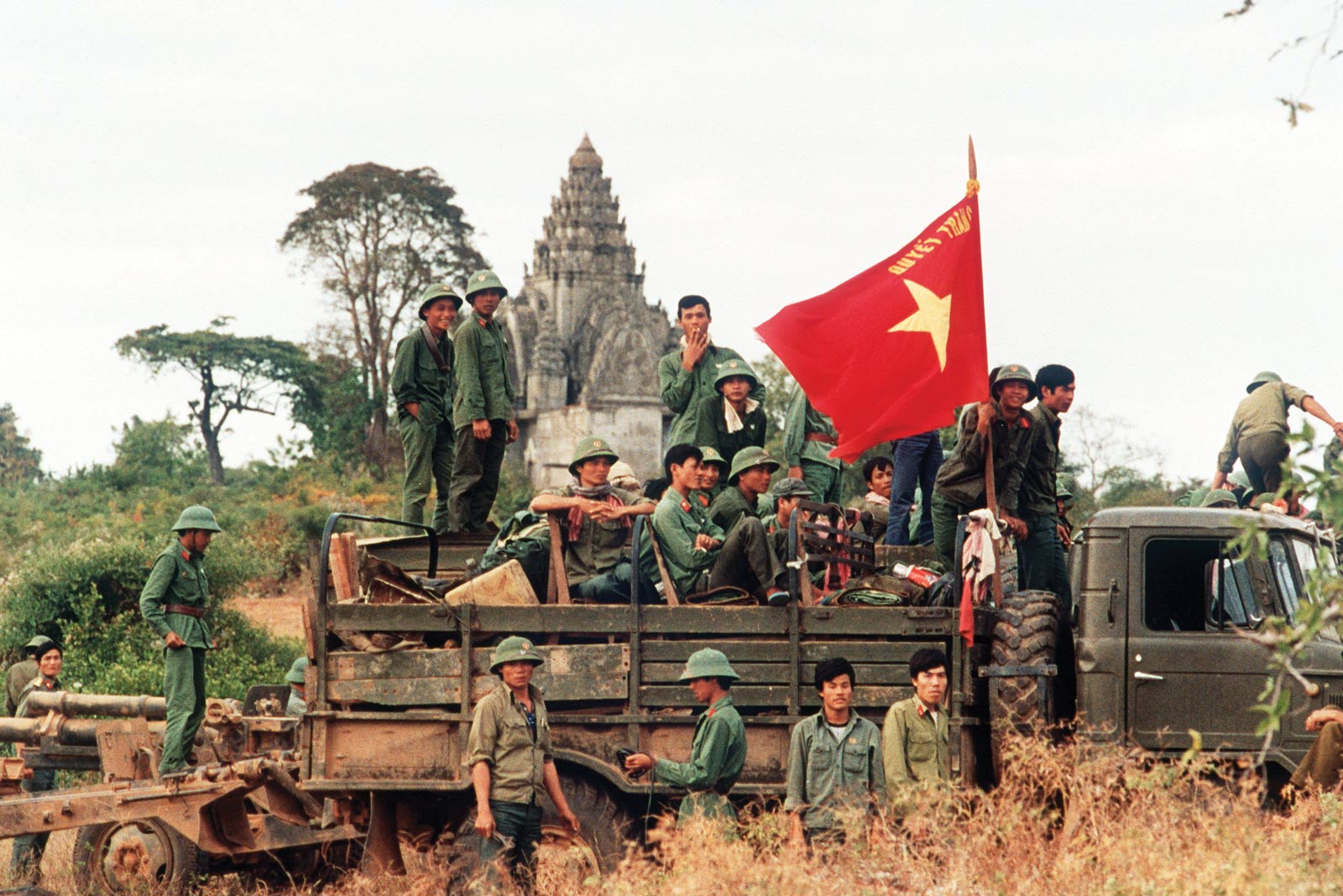
Vietnamese troops in Kampong Cham, Cambodia, before their withdrawal in 1989
Warren Christopher, US Secretary of State, and Nguyen Manh Cam, Vietnamese Minister of Foreign Affairs, signing a protocol opening diplomatic relations between the two nations on August 5, 1995
VIETNAM TODAY
Since the 1990s, Vietnam is finally at peace and the reconciliation with major nations opened many doors. The government took a pragmatic approach and first focused on economic matters by authorising a relatively liberal foreign investment law and decollectivizing agriculture, significantly reducing the number of state-owned enterprises. The results of these liberal measures were a frank success and food stock increased sufficiently for Vietnam to start exporting rice. Many jobs were created in the private sector and foreign investment grew in several domains including tourism which is now considered a key economic sector. Through the decade, growth in the Gross Domestic Product (GDP) averaged nearly 8 percent annually.
These liberal measures however represent a concern when it comes to preserving Vietnam’s socialist orientation. Leaders were worried than foreign investments would bring too much corruption, inequality and materialism, hence undermining the Party. In consequence, in 1999, Vietnam refused to sign a trade agreement with the US which would have secured them a place in the World Trade Organisation (WTO). This decision slowed down the fast progression of Vietnam, ultimately resulting in the replacement of the Party leader. In 2001, negotiations rekindled and an accord was signed with the US, leading to a membership in the WTO in 2007. Since 2010, Vietnam’s GDP growth has not been lower than 5 percent, making it one of the fastest growing countries in the world.
The future is looking bright for Vietnam and following the Covid-19 pandemic, its reaction and ability to handle the situation, caught the world’s attention. The country being such a safe place, foreign investment is growing stronger and the country ranks high in the favoured holiday destinations. Vietnam is growing mixing a sense of tradition with modernisation, which makes it undoubtedly, a fascinating place to visit.

Ho Chi Minh City (previously Saigon) South Vietnam